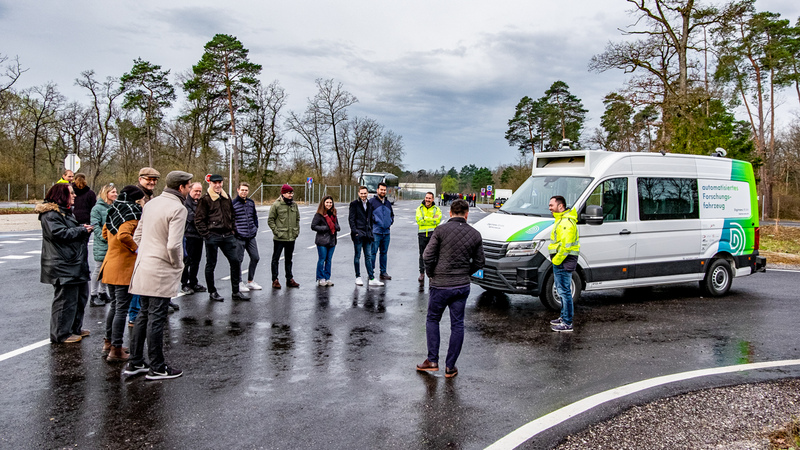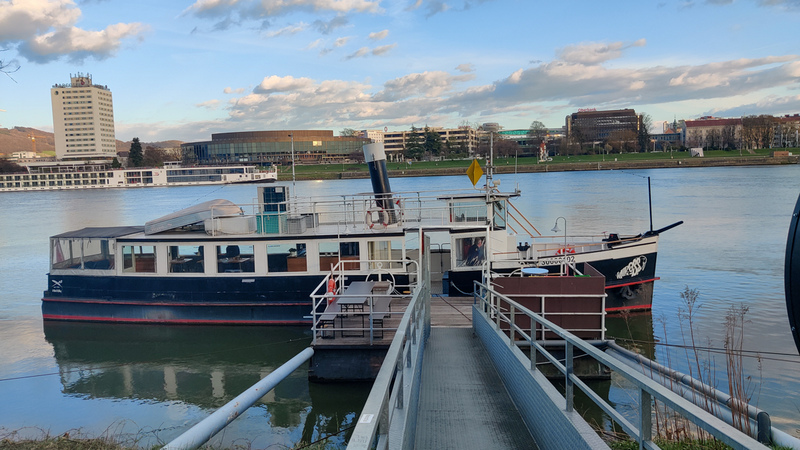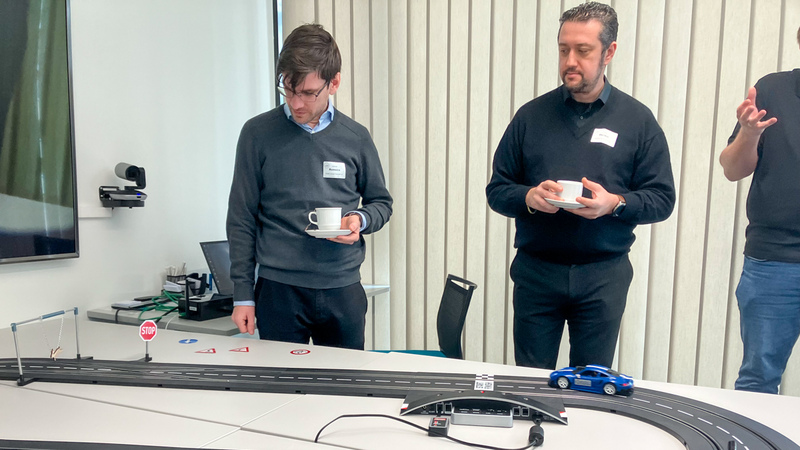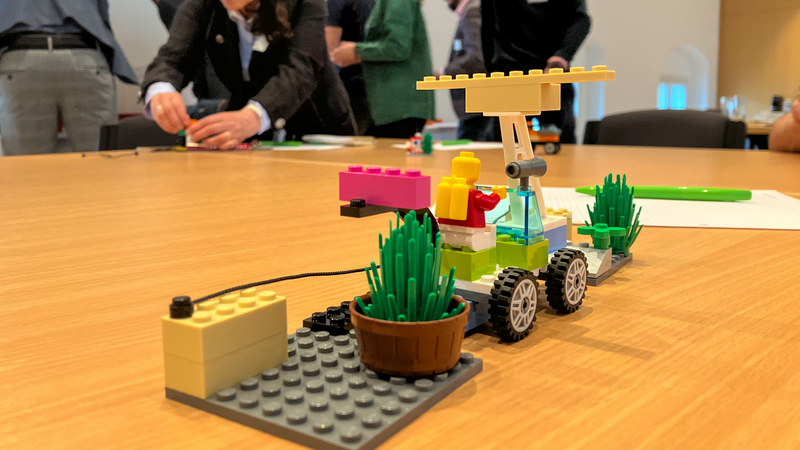
In the LEGO® SERIOUS PLAY® workshop, participants:inside developed business models for a MaaS solution for an autonomous shuttle. © Business Upper Austria
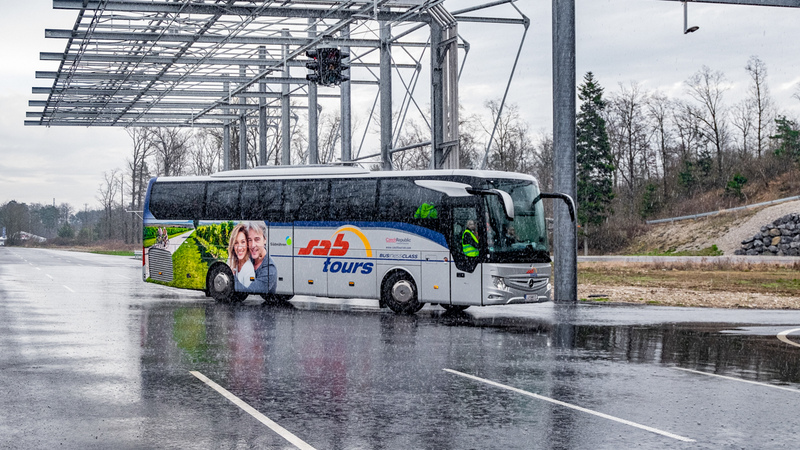
Mobility Mission Austria participants experienced the sprinkler system of DigiTrans GmbH's test track for automated driving in St. Valentin up close during a "test drive" in their coach. © DigiTrans GmbH
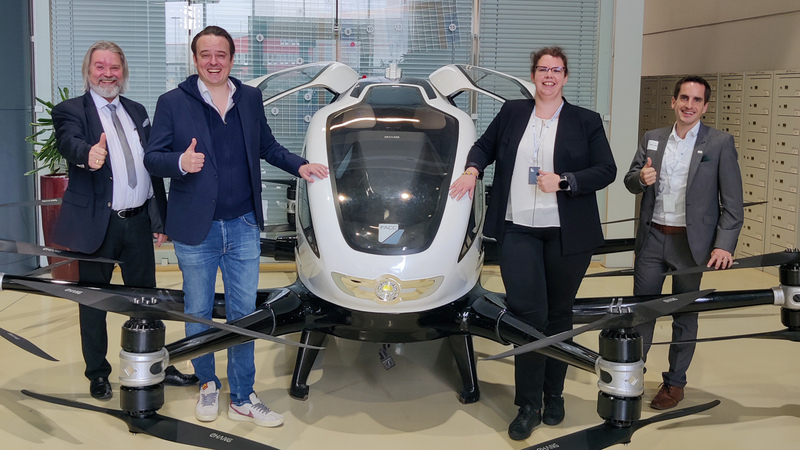
From left: Uwe Breitschopf (LINZ AG), Andreas Perotti (FACC), Doris Straub (Automobil-Cluster), Michael Nikowitz (BMK) with the cab drone at FACC in Ried im Innkreis. © Business Upper Austria
How does a cab drone work? What are charging robots? And what happens when the cameras of autonomous vehicles cannot read traffic signs correctly? These and many other questions were explored by 50 participants from all over Europe for four days at the Mobility Mission Linz as part of the EU project RECIPROCITY. The invitation and the program were put together by the Automotive Cluster of Business Upper Austria.
50 representatives of European municipalities, politicians, companies and project partners accepted the invitation of the Automotive Cluster and toured through Upper Austria from March 28 to 31 to learn about innovative mobility concepts. They came from Albania, Austria, Belgium, Czech Republic, Finland, France, Germany, Hungary, Norway, Romania, Turkey and Ukraine.
Crash me if you can
Already the first program item on the first day started in an exciting and practical way. Using a toy car racetrack, RISC Software GmbH demonstrated its research project "Crash me if you can". It is about how cameras in vehicles recognize traffic signs and how recognition is influenced by weather, pollution, stickers on the signs or hackers. Using the car racing track, Stefan Thumfart showed how the algorithm interpreted the 70-kmh speed limit as a 100-kmh speed limit, the car was going too fast and therefore caused an accident.
The Austrian way
Michael Nikowitz from the Federal Ministry for Climate Action presented the Mobility Master Plan 2030, the associated projects and planned legislative changes. Priorities include the expansion of public transport, climate-neutral last-mile solutions and multimodal traffic management. "Automation and digitalization are key to achieving the SDGs and will be part of smart cities," Nikowitz said.
The future of charging
In the future, anyone who parks their electric car in a parking lot for a longer period of time - for example, at work or at the airport - could use the charging robots from ALVERI GmbH in Ried im Innkreis. "Parked e-vehicles are simply charged autonomously by the ALVERI CHARbO. Without manual assistance, the CHARbO recognizes the vehicles and starts the charging process," explained Ehsan Zadmard. One robot manages 20 vehicles, and login works via an app.
Tramping yellow angels
Günter Klaus from ÖAMTC, among others, told the audience what impressive things are happening in Vienna in terms of smart city and mobility: "Our breakdown services are on the road with e-bikes, the so-called breakdown bikes. They have everything they need with them. In 90 percent of cases, they can fix the breakdowns." Christoph Singelmann of Urban Innovation Vienna presented the city's Smart City Mobility Strategy. Sharing concepts, subway expansion and the combination of sharing - also for vans - with public transport and city bikes by means of an app were the topics.
Paris city cable car
The Regional Management Upper Austria presented on-demand services in combination with public transport in numerous communities. Benedikt Prinzing from Doppelmayr Seilbahnen impressed with the City Cable Cars, which have been in operation for a long time in Mexico City, for example, and are currently being built in Paris. The day ended with a networking evening and the Mural Harbor boat tour in Linz's Danube harbor.
Smart traffic lights for Linz
Hans-Martin Neumann and Deputy Mayor Martin Hajart provided insights into the city of Linz's plans for expanding its network of bike paths and smart traffic lights. The smart traffic lights are to be implemented and tested as part of the "X4ITS" research project. "With this, we want to investigate, among other things, the harmonization of cooperative intelligent traffic systems and services in the city of Linz," Neumann said. Specifically, this involves communication between cars or with traffic lights. "With the information gained from this, we can improve the safety and guidance of traffic as well as reduce emissions," Hajart added.
Drones as taxis
The highlight of the second day was the plant tour at the headquarters of the aerospace company FACC AG in Ried im Innkreis. Andreas Perotti from FACC and Uwe Breitschopf from LINZ AG provided information on the status quo of the cab drone project in Linz. In China, these are already on the road, and in Linz - depending on the official approvals - it is hoped that this will soon be the case, at least with unmanned test flights. "The autonomous drones are to operate on demand along predefined flight routes - for example, between Linz Central Station and the airport in Hörsching," Perotti and Breitschopf described. Other planned reds include between LINZ AG's headquarters on Wiener Straße and the port, from the port to Urfahr, or between the port and SolarCity.
Focus on hydrogen
In the afternoon the RECIPROCITY delegation visited the session "Efficient and networked mobility" at the Future Forum Upper Austria. Exciting presentations on hydrogen technologies and their possible applications, new battery technologies, e-fuels, fuel cells and electromobility were on the agenda. Hydrogen was also the dominant topic on the second evening. The EU project "Hy2Market" aims to establish a hydrogen value chain throughout Europe. Hydrogen buses and hydrogen-powered trucks are already on the road in the alpine region of Tyrol as part of the "H2Alpin" project.
Autonomous shuttles
Markus Tauchhammer presented the SURAAA (Smart Urban Region Austria Alps Adriatic) project, an autonomous shuttle operating in Pörtschach that has been well received. Autonomous shuttles from SURAAA are already on the road in several cities and towns, with more to follow. The on-demand public transport software solution from France-based Pandam Mobility is already used in 15 countries worldwide. "It is also suitable for autonomous shuttles," Javier Guimera pointed out. Karma Islam from the EU innovation network EIT Urban Mobility and Zuzana Lettner from Business Upper Austria provided information on funding, financing and support opportunities at European, national and regional level.
Touring the test site by coach
What the DigiTrans GmbH test track for automated driving in St. Valentin is good for, the guests tested on the third day. The tour bus took them over individual sections of the test track and through the sprinkler system. "We were able to experience the difference between light and heavy rain up close and live," described Doris Straub, project manager at Automobil-Cluster. Managing Director Alexander Barth explained to the guests the research activities and tasks of DigiTrans GmbH, the purpose of the test track and presented the newly arrived automated research vehicle, the Digitrans eVAN.
Capacity Building Workshop
In the afternoon, the tour of the Magna Steyr plant was on the agenda. The capacity building workshop also took place there. The participants chose the topics autonomous shuttle, on-demand shuttle, smart traffic lights, mobility app as well as car, bike and scooter sharing. To do this, they worked on questions such as: Do I already have a solution? What barriers make it difficult to implement? What laws would need to be changed? How can I finance the solution?
Sustainable mobility solutions
At the University of Applied Sciences Upper Austria Campus Steyr, the MobiLab team around Wolfgang Schildorfer informed about its research on sustainable mobility solutions. Examples include the Domino App for carpooling, last-mile logistics solutions or hydrogen in freight transport. Daniela Zeiner, Managing Director of Zukunftsregion Steyr, described how the city of Steyr is intensively engaged in mobility topics. "We involve all stakeholders, from the mayor to the companies and their workforce to the population," she said. "In the process, we collect lots of ideas, some of which have already been implemented." These include, for example, children's cabs as carpools, where parents take several children to school by car, not just their own.
Making business models out of Lego
The Mobility Mission Linz ended on a creative note on the fourth day with the LEGO® SERIOUS PLAY® design thinking workshop, led by Business Upper Austria. In the Old City Hall of the City of Linz, the participants developed business models for a Mobility-as-a-Service (MaaS) solution for an autonomous shuttle.



